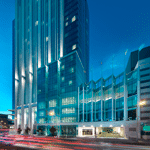
Charged with reaching LEED Gold, InterContinental director of engineering Harry Hobbs took full advantage of the Pacific Energy Center across the street to prove that high-efficiency lighting can work in an upscale hotel.
It’s the more luxurious side of sustainability, a side necessarily inhabited by many hospitality groups, which cater to guests who hold varying ideas about ‘being green.’ In 2011, the InterContinental Hotel–San Francisco was certified LEED-EB Gold due to massive green measures spearheaded by Harry Hobbs, the hotel’s director of engineering. Hobbs and his staff have achieved their successes through various initiatives and a clear commitment to helping the environment without sacrificing the look, feel, or experience of the hotel.
Before the doors opened in 2008, management made clear that a culture of sustainability and responsible business practices needed to be developed. Initiatives were already beginning to take place, and Hobbs wanted to have an opening day pep rally. “I had 250 of our new employees raise their right hand and solemnly pledge that they would support our efforts to green the hotel,” he says. “I had been exposed a few years prior to the LEED process and was absolutely convinced that its approach toward third-party validation of green practices was the right way to go.”
Hobbs says many people make claims about a building’s green aspects, but sometimes if you lift the hood, you might find that those are exactly what they are—merely claims. Hobbs’ goal was to separate the hotel from the world of empty claims and make it evident to its guests that the InterContinental had “walked the walk.”
Hobbs says he couldn’t have achieved this without his LEED consultant Jubilee Daniels, who was a key team member in helping the hotel achieve its Gold status. “She worked tirelessly,” Hobbs says. “She brought vigor and tenacity to the project. There is no way I could ever repay her.”
PROJECT
Location San Francisco
Size 600,000 ft2
Completed 2011
Program Hotel
TEAM
Client InterContinental Hotel–San Francisco
Architect Patri Merker Architects
Lighting Consultant Pacific Energy Center
Lighting Designer Luminae Souter Associates
GREEN
Certification LEED Gold
Water Faucet aerators reduce flow to 0.5 gpm
Energy LED lighting, water-side economizer
Recycling Hotel-wide recycling program
Cleaning Green Seal Certified chemicals, HEPA filtered vacuums, micofiber cleaning cloths
Achieving the Energy Star label was an equally important feat for the InterContinental, and it wasn’t an easy battle. When the hotel debuted in 2008, it was rated 69 on Energy Star’s scale of zero to 100, six points shy of the level required for a label. But fortunately, the building was part of a USGBC pilot program, in which 50 hotels were shepherded through the Energy Star process. Only three went on to obtain the label—and the InterContinental was one of them.
“Many of that group dropped out because they were in the thirties and forties and fifties and saw no hope of being able to achieve the threshold of 69 to qualify for LEED certification, let alone 75 to get an Energy Star label,” Hobbs says. Three to four months into the project, Energy Star underwent changes, which gave the hotel a new, higher score of 64. But through rigorous energy-saving efforts, that score climbed to 87 within just a few years. “My utilities rep at Pacific Gas and Electric said he knows of no other hotel that has achieved an Energy Star rating as high as ours,” Hobbs says.
Finding the perfect energy-efficient lights for the InterContinental was one of the biggest issues. However, Pacific Gas and Electric’s Pacific Energy Center (PEC) was conveniently across the street from the hotel, and Hobbs took full advantage of the resource. “I started to knock on their door and say, ‘Hey, let me be your living room; let’s work together to demonstrate that emerging technologies can have a place in a high-end luxury hotel that is aesthetically acceptable,’” Hobbs recalls.
The PEC and Northwest National Lamps partnered with the InterContinental to work on finding the best lighting for the project. After a rigorous elimination process, Hobbs and his team selected six different bulbs and then fitted them into the existing fixtures for a test run one night. The light output by the energy-efficient bulbs was much less than expected. “We were absolutely disgusted with the output,” Hobbs says. “We were about six to eight months into the project and didn’t feel like we had a win at all.”
A few days after the big letdown, the lighting designer, Michael Souter of Luminae Souter Associates, presented an MR-16 LED. “We went into the hotel hallway and put it in a fixture illuminating artwork,” Hobbs explains. “He glowed when we looked at the output. When I showed it to our ownership group they said it was better than the original.” Overall, the hotel installed 1,000 LED bulbs, which helped the InterContinental save nearly $40,000 a year in electricity costs.
A huge contribution to the Energy Star label was the 2010 installation of the water-side economizer for the rooftop HVAC system. The InterContinental spent $250,000 flying the heat exchanger device to the roof of the hotel, modifying its chiller piping, and implementing the device. The projected return on investment, based on calculations, indicated that management could expect 1,800 hours of economizer operation, but the hotel has seen substantially more savings, reducing energy demand for air-conditioning by eight percent and saving $75,000 a year in electricity costs. The Energy Star rating went up to 79 in the following year.
Water conservation can be a tricky category for hotels because they have so many guests on any given day, but the InterContinental saved as much as possible by installing aerators that reduced fixture use to 0.5 gallons per minute, saving approximately two million gallons of water per year. And although the LED lights, HVAC systems, and low-flow fixtures aren’t really there to dazzle the clients of the hotel, the InterContinental Hotel–San Francisco’s efforts prove that luxury and sustainability can go hand-in-hand.

